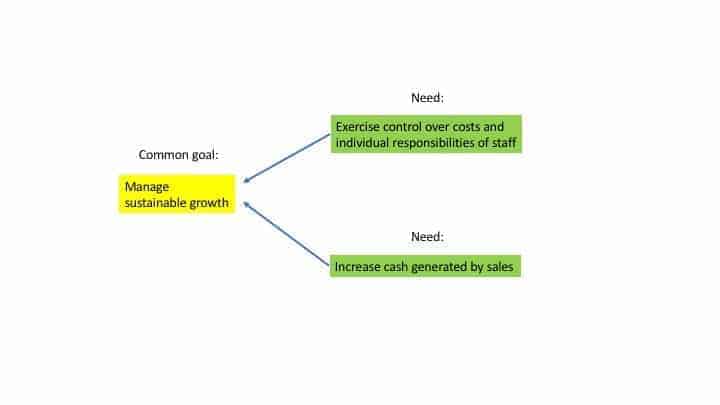Silo sickness
When organizations are created and organized in a matrix of vertical hierarchy and functions, an inevitable consequence is the existence of a series of “walls” or divisions. These barriers inhibit the resources involved in producing an optimal result toward the overall goal. Communication gets slowed down or completely blocked, innovation struggles to emerge through the ranks and bureaucratic practices, projects are delayed and go over budget, quality suffers, and reaction time to changing market demands is too slow.
Individuals suffer because they do not have the authority to carry out the tasks for which they are responsible. Careers are limited because people work for a boss who must improve their own performance in a vertical way. This means that competencies, both technical and managerial, do not find a natural way to develop. This lack of development creates frustration due to artificial “ceilings.”
At the organizational level, departments carry out their work based on the local measurements and therefore focus on local optima, losing sight of the overall goal of the organization. Production planning, for instance, in the steel industry can be completely uncorrelated with sales. This is because there is no feedback mechanism within the organization (and poor interdependence with customers and suppliers).
Even more dramatically, silo sickness means that the larger implications of cause and effect relationships that exist in organizations are totally disguised. It takes time for the effects of a cause to propagate through a system. People have no means of understanding the implications of their local, siloed decisions for the big picture. Even the heads of functions are blind-sided to those implications.
For example, let’s say that the VP of Operations decides to cut 5% of maintenance costs. A moment will come when the organization is unable to make a sale because it is unable to deliver what it has promised due to breakdowns, and nobody will ever know that the problem originated in the cutting of maintenance costs.
These are just some of the ailments of a traditional organization. We can summarize the three worst faults in an organization that operates in silos as follows:
- No feedback mechanism
- No visibility of the customer (and suppliers) in the organization
- No learning cycle based on feedback
So why do silos exist?
Why do people work in silos in the first place? Surely people are trying to do their best, so why do they work in a way that sub-optimizes everything? What is the root cause? To understand that we must look at the two major needs that an organization tries to protect: On the one hand, exercise control over costs and the individual responsibilities of staff and on the other hand, increase cash generated from sales.

Both needs have the common goal of “Manage sustainable growth”. However, there are a set of assumptions (mental models) that make people think that a traditional hierarchical/functional organization is a better way to control things.
Mechanistic thinking can’t cope with complexity
The hierarchical/functional organization reflects a mechanistic, Newtonian worldview, where separation is feasible and dynamics are linear. This attitude lacks awareness and understanding of our new reality that is dominated by increasing complexity, meaning unprecedented levels of interdependencies.
To move forward, we must question the assumptions, i.e. mental models that account for the persistence of traditional hierarchies despite their shortcomings. Over the years of our on-the-field research and development, at Intelligent Management we have come to summarize the major assumptions of the conflict adopt a hierarchical structure vs. not adopt a hierarchical structure as:
- A hierarchy can only be vertical;
- Control must be exercised equally over all components of the organization;
- The global optimum is equal to the sum of the local optima.
To challenge these assumptions operationally we need a plan of action that can transform an organization into a whole system. The question then becomes, if a traditional hierarchical/functional organization creates silos when what we need, instead, is to work as a whole system, how can we best manage the interdependencies? If we don’t have functions and traditional hierarchy, then, you may be wondering, where is that command coming from and how do we “control” this kind of an organization?
Standing on the shoulders of giants
The good news is that we don’t have to reinvent the wheel. The model for organizations to follow has been around for decades. Dr. W. Edwards Deming, the founding father of Quality, looked at the big picture of how elements of a system interdepend, as we mentioned in our previous article ‘Building Organizations Fit for the Digital Age’. Deming has shown us that it is of fundamental importance to recognize that an organization is a system, i.e. a network of interdependencies that work together to achieve a shared goal.
After Deming, another management giant who was also a physicist, Eliyahu Goldratt, introduced the concept of accelerating flow through a strategically chosen leverage point, or “constraint”. Taken together, the contributions of Deming and Goldratt provide us with a meaningful and effective way to overcome silos, well beyond various techniques that may be appropriate for software teams but not for shifting entire organizations.
We are talking about nothing less than transformation (to quote Deming). Transformation of the prevailing management style based on hierarchy and artificially created silos towards one of system optimization.
With this article, Domenico Lepore continues his mini-series of articles that focuses on how to build companies that are fit for the digital age. The next one will be about ten steps for transformation.






















Add Comment